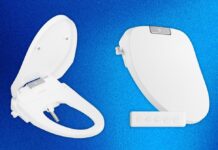The following is a transcript of a report from “Full Measure with Sharyl Attkisson.” Watch the video by clicking the link at the end of the page.
The pandemic shutdowns have left us with fewer jobs, more people on unemployment, and rising household debt. But as destructive as it’s all proven to be for so many, there are winners to be found in the Covid economy. Today, we examine the dollars and cents behind some of the booming industries that have found themselves well-positioned for catastrophe.
The silver lining in the Covid economy is reflected in swimming pools.
In 2019, American homeowners spent $3.9 billion building 78,000 new pools. But in 2020, while drowning in Covid, we spent $5.4 billion on 96,000 pools, a record 24% growth for the industry.
Today, there’s still so much demand, there’s a backlog.
Peter Morici: “Well, some people were just positioned for a catastrophe.”
Economist Peter Morici says it’s clear the Covid shutdowns have spurred transformative changes in the American economy and society.
Morici: We had the same thing with World War II. Radar is nothing but television and television was languishing in the late thirties waiting to happen. All the burst of usage during the war of those kinds of technologies caused it to just burst right after World War II.
During World War II, a device called the cavity magnetron generated microwaves for advanced radar war technology and after the war, the technology was used to develop microwave ovens, then networks to send TV signals.
Morici: And that was really transformative. Television became a major part of American culture. It could do things that the newsreels, at the movies, and the radio couldn’t do. Likewise, Zoom is transformative, or Meets, or all these collaborative technologies because they’ve been waiting to happen for a long time.
Almost overnight, it seemed, video conferencing took on a role in nearly every aspect of American life. Zoom users increased from 10 million to 300 million.
In 2019, Zoom’s pre-tax profits were $16 million dollars.
In 2020, that number shot up nearly 4,000% to $660 million with even bigger increases this year.
A related phenomenon, remote medical care.
Morici: There’s a lot of things that doctors used to do by telephone back when I was a kid in the fifties, simply because they had so many patients, they didn’t worry about getting paid. Then we got into an era of insurance and payments were controlled, and all that. And the only way you got paid in that system was if you showed up at the office. Well, insurance companies, Medicare, decided to go along with telemedicine. That is, medicine by telephone and video.
In 2019, total revenue of the top 60 virtual health companies added up to about $3 billion dollars.
In 2020, it was $5.5 billion.
This year, 84 percent of doctors are still offering virtual visits.
Other industries found themselves on a much-publicized roll during Covid shutdowns.
In a typical year, Americans spend $9 billion on toilet paper.
But in 2020, the industry found itself flush with cash and $11 billion in spending.
And hand sanitizer jumped from 2019 sales of $200 million to $1.4 billion in 2020, a clean 600% increase.
A lot of Covid changes, and profits, centered on food.
The restaurant industry was devastated, with 110,000 dining outlets reportedly shuttered.
But in many U.S. locations, fast food icon McDonald’s never closed, and was all set with drive-thru, take-out and delivery.
Morici: They were positioned. They’ve had a drive-in culture since the sixties. So people that would go inside and sit down, just got on the drive-in line. McDonald’s is equipped to essentially deliver sandwiches through those windows more efficiently than at the counter.
Instead of losing money, McDonald’s same-store sales in the U.S. rose slightly in 2020. U.S. franchisees made more money, too, hitting all-time highs, increasing operator cash flow by nearly $40,000 per store.
With dining out options limited, we bought more at the local grocery. Consumers proved willing to shell out to have store employees do the actual shopping, and deliver the groceries or serve them up curbside.
Morici: People ended up paying 20 to 40% more for their groceries. And I was surprised they were willing to pay for it. But I know people that did it, especially all the empty nesters, the ones with the kids out the door. They spent like the kids were still at home, but they only ate for two.
In 2019, Grocery store retail sales were $693 billion.
In 2020, they reached $773 billion with the boom continuing this year.
The meal kit home delivery business also got a big boost.
In 2019, HelloFresh struggled with a net loss of $445 million.
In 2020, it posted a $446 million net profit… and still beating expectations in 2021.
And we drank plenty, too, just not as much at the local bar.
Morici: Alcohol sales did well because, but it depends on again, whether you are selling to bars or you are selling to people in their homes that consumed at home. Alcohol sales did well for people that consumed at home.
In 2019, beer, wine and liquor stores pulled in $56.8 billion.
In 2020, they were toasting a 10 billion dollars increase to $66.8 billion.
Spirits sales have remained high this year.
America’s hospitals became pivotal during the pandemic. At many of them, admissions were down. But major hospital chains recorded profits, with help from U.S. taxpayers.
In 2019, Community Health Systems had a net loss of $675 million. That turned into a net income of $511 million in 2020. The company got $448 million in taxpayer money from Covid relief funds.
Universal Health Services ended 2019 with about $815 million net income. In 2020, that shot up to $944 million. UHS got $413 million in Covid money.
University of Pittsburgh Medical Center had $420 million in revenue after expenses in 2019. That shot up to $1 billion in 2020. The company got $1.1 billion in taxpayer Covid relief funds.
And America’s largest hospital system, HCA, made $1.1 billion in profits in 2019. But ended 2020 with $3.8 billion. HCA got a whopping $6 billion in Covid-19 relief funds— but ultimately decided to return the taxpayer money.
Few bank accounts swelled more than those of big players in the vaccine industry, which got at least $12 billion of US tax dollars to develop and produce vaccines
Moderna received nearly a billion tax dollars in tax money related to vaccine development, then got $1.5 billion more for the first 100 million doses.
Pfizer passed up federal funds to develop its Covid vaccine, though it’s said to have benefitted from taxpayer-funded research. And taxpayers gave Pfizer $2 billion for the first 100 million doses.
The pandemic even reportedly made nine new vaccine billionaires, worth a combined $19.3 billion.
Moderna’s CEO, chairman, top investors, and vaccine producer; CEO of BioNTech, Pfizer’s vaccine partner; and three founders of China’s vaccine manufacturer: CanSino Biologics.
But perhaps one of Covid’s biggest surprises turned out to be America’s housing boom.
Sharyl: Would you have guessed that the home sales industry would be doing so well?
Morici: No, I would not have. I thought people would be more hesitant than, and afraid, but what we quickly sorted out within about three months was that we were going to be at this for a long time.
How big is the boom?
In 2019, 6.53 million existing and new homes were sold.
In 2020, that number topped 7 million.
Today, they’re still on an upward trend.
More places to build all those pools.
Sharyl (on-camera): The Christmas forecast is out, and not counting cars, gas and restaurant retail sales for this month and next month are forecast to grow up to 10-and-a-half percent over last year, for a record $859 billion.









